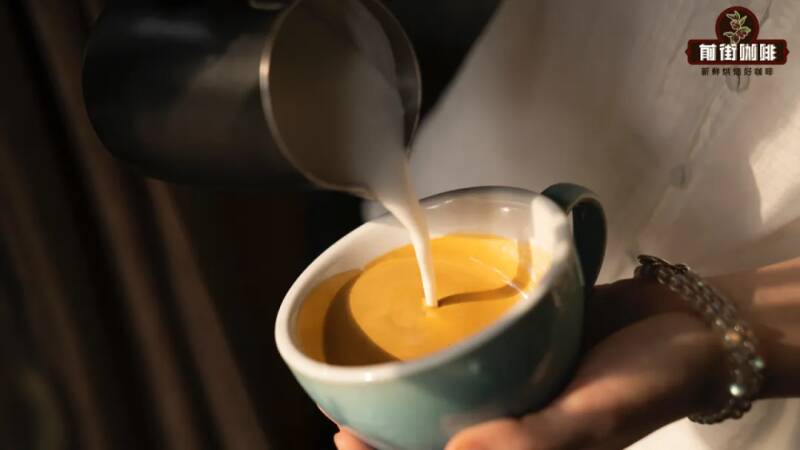What is the difference between the foam of a latte and white cappuccino? How thick should Latte's milk foam be made? What's the difference between a cappuccino and an Australian white latte?
Even if we have the same few ingredients, as long as the ratio is different, we can have unlimited possibilities. Coffee is a good example.

Take the "three dairy and coffee swordsmen" that are often shared by Front Street, such as latte, Australian white, and cappuccino. Their production materials only use milk and coffee, but they are all very different in terms of taste and texture. These differences come not only from the different proportions of milk and coffee, but also from the different thickness of milk foam. Therefore, friends often ask Qianjie how thick the foam of these dairy coffees is.
So today, the front street will share, latte, cappuccino, Australian white, these three milk coffee popular players, their milk foam is how thick, and then what kind of impact will bring to coffee ~(about these three milk coffee ratio, front street in the "portal" article has a detailed explanation, this article will not repeat too much ~)
What is foam? What does foam affect? "Milk foam," that is, milk foam. Its production principle is very simple, just injecting air into milk to produce it. However, if it is to be used in the making of coffee, it is necessary to cut the large particles of bubbles into countless small bubbles by weaving to make them delicate and dense.
Although the milk foam for coffee is usually made from the steam stick of the coffee machine, it is not limited to this. Tools such as electric mixers and pressure pots can all complete the production of milk bubbles, but they are relatively difficult to control the thickness of the milk bubbles. The thickness of milk foam affects many aspects, such as the difficulty of drawing flowers, the texture of coffee, and the proportion of milk in the cup. Therefore, the thickness of the milk foam can become a major feature that distinguishes latte, capablo, and Australian white.
The thickness of cappuccino foam is the thickest of the three. Usually its foam is a bit higher than the cup, which is the so-called "11 points full." Because of this, the characteristics of cappuccino are very obvious and easy to recognize. As long as we see a cup of milk coffee with high bubbles like a "hamburger", there is a high probability that the cappuccino has not escaped.
Generally speaking, the foam thickness of a cappuccino will be about 2 cm, depending on the cup type used and the barista's understanding of the cappuccino (the difference between dry and dry cappuccino). In order to make such thick milk foam, we need to ensure that there is enough time for the steam to bring air into the milk when we start to pass, that is, the air intake must be sufficient and the foaming time must be long enough.
Take Qianjie as an example. The machines used in Qianjie have moderate steam intensity, so when blowing the milk bubbles of cappuccino, the foaming time will be controlled to about 3 seconds. Such a time not only allows the coffee to gain a rich foam layer, but also leaves enough time to foam the milk foam. But because the milk foam is too thick and the liquidity is too poor, we have no way to make an exquisite drawing pattern for cappuccino, so generally simple white heart drawing flowers are standard for cappuccino. Such thick milk bubbles will bring a more dense touch to the coffee, making it feel like eating cotton candy in one bite.
Compared with cappuccino, the thickness of latte foam is much thinner, about half of that of cappuccino, and about 1 cm thick. The reason why latte foam is thinner is initially because it wants to have a higher proportion of milk in the cup.
Previously, Italian milk coffee had only one type of cappuccino, but many people couldn't accept the overly strong coffee flavor of cappuccino, so more milk was needed to dilute the bitterness of the coffee. By reducing the thickness of the milk foam, the cup can accommodate more milk, and the bitterness of the coffee can be balanced (it can also be understood that the thickness of the milk foam is reduced in order to increase milk). Later, people accidentally discovered that milk foam could draw patterns on the surface of coffee, the so-called pulling flower. Lahua is very particular about the milk foam of coffee and needs the right thickness to better draw the pattern. Too thick or too thin will affect the drawing due to too low and too high liquidity. So gradually, the foam of the latte evolved to its current thickness. It has the right amount of liquidity and can easily create all kinds of patterns we want.
Different from cappuccino foam, latte foam will be relatively uniform. No matter which cafe it is, the foam thickness of latte foam is basically about 1cm, so everyone's foaming time when making it. is similar. Take Qianjie as an example. It takes about 1 second for Qianjie to bubble the milk foam for lattes, and then it starts to perform the foaming step. In addition to the more refined pull flowers, such a moderate milk foam can bring just the right taste improvement to the coffee, giving the coffee a soft touch and a smoother taste.
The thickness of milk foam in Australia will eventually be Australia white! Australian white milk foam is the thinnest of the three. How thin is it? When foaming, we only need to gently nourish it and put in a little air. The final milk foam will be about 0.3mm.
The reason why the milk foam of Australia White is so thin is for the simple purpose, which is to give the coffee a smoother taste and make it easier to taste. If cappuccino and latte want the "cotton" brought by milk foam, then Australian White pursues the silky "slippery"! Qianjie mentioned earlier that the texture of milk bubbles of different thicknesses will be different. Thicker foam will give the coffee a dense touch, while thinner foam will make the coffee drink smoother. And milk foam (about 0.3mm) with the thickness of Australian white will make coffee very silky! Coupled with short extract concentration, the coffee is strong but not bitter, but also has a smooth taste, making it very easy to eat. This is also why Australia and Belarus are so popular.
But there is one disadvantage when milk foam is too thin: it is too fluid. Milk foams with excessive liquidity are not suitable for pulling flowers because they are not easy to control and stable enough. Therefore, many coffee shops do not carry out flower pulling when producing Australian white, but they directly integrate it with coffee.
So the above is the difference between the three common coffees. Cappuccino has the thickest foam, lattes have the moderate foam, and Australian white has the thinnest foam. It is worth mentioning that in addition to these three, there are many other Italian milk coffees on the market, such as mocha, macchiato, piccolo and other milk coffees that can be pulled. The foam of these coffees without exception is the same thickness as that of latte ~
- END -
Important Notice :
前街咖啡 FrontStreet Coffee has moved to new addredd:
FrontStreet Coffee Address: 315,Donghua East Road,GuangZhou
Tel:020 38364473
- Prev

The right way to drink espresso! How to drink coffee best? Do I have to gulp dirty coffee?
Although how to drink coffee as a drink can depend on one's preferences, it is easy for us to miss out on some of the unique delicacy of coffee. The characteristics of coffee are not only the taste, but also the feeling it brings when tasting. Just like Dirty, if you stir it and drink it, it will almost be similar to the same.
- Next

Coffee shop specialty American production ratio step by step tutorial KFC apple bubble American practice
When it comes to summer coffee, we always think of classic drinks such as ice American, cold extract, and ice drops. However, after all, we are in the hot and hot season. People always want to eat something that can open up their taste buds, and then seek to match it. To make black coffee more delicious, gradually, it evolved into various interesting and delicious drinks
Related
- What is the standard process for the purpose of coffee cup testing? What is the difference between hand-brewed coffee and cup testing?
- How to use hand-brewed coffee paragon small golden balls? How does cold coffee lock in the aroma of coffee?
- Is American coffee black? What is the difference between American coffee and drip coffee?
- Unexpected! Well-known tea beverage brand Lele Tea will withdraw from the Zhengzhou market!
- Starbucks enters the fashion and beauty industry?! Netizen: Give me an ice American eye cream
- Why can American refills for free? The difference between Americano and American drip pot coffee
- Being chased out of the rain in front of Starbucks?! Store: Sheltering from rain under umbrellas poses a safety hazard
- The white moonlight has changed?! Lucky launches "Big Winter Pear American"
- Hand-brewed coffee three-stage method, high-sweet and universal brewing method to share! What does the high sweet water level of hand-brewed coffee mean?
- What is the difference between raw, refined and full espresso coffee? How to extract espresso and taste good?

